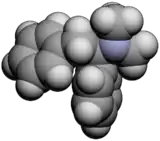 | |
 | |
| Clinical data | |
|---|---|
| Routes of administration | Oral |
| ATC code |
|
| Legal status | |
| Legal status |
|
| Identifiers | |
| |
| CAS Number | |
| PubChem CID | |
| ChemSpider | |
| UNII | |
| CompTox Dashboard (EPA) | |
| Chemical and physical data | |
| Formula | C16H19N |
| Molar mass | 225.335 g·mol−1 |
| 3D model (JSmol) | |
| |
| |
| | |
Lefetamine (Santenol) is a drug which is a stimulant and also an analgesic with effects comparable to codeine.
Discovery
Lefetamine-related 1,2-diphenylethylamines were invented in the 1940s and showed weak analgesic activity.[2]
It was investigated in Japan in the 1950s.[3] The L-isomer showed weak analgesic action comparable to codeine and antitussive action far weaker than codeine. The d-isomer showed no such activity but caused seizures in rats.[4][5]
Society and culture
It was abused in Japan during the 1950s. In a small study in 1989 it showed some effect against opioid withdrawal symptoms without causing withdrawal symptoms itself. It was concluded that it may be an opioid partial agonist.[6]
It has been abused in Europe; in 1989 a small study of 15 abusers and some volunteers found that it had some partial similarity to opioids, that it produced withdrawal symptoms, and had dependence and abuse potential to a certain degree.[7]
In a small study in 1994, it was compared to clonidine and buprenorphine in the detoxification of methadone patients and found to be inferior to both of them.[8]
Regulation may vary; it does not appear as either a narcotic or non-narcotic under the US Controlled Substances Act 1970 [9]
The Canadian Controlled Drugs and Substances Act was amended in 2016 to include the substance as a Schedule III substance. Possession without legal authority can result in maximum 3 years imprisonment. Further, Health Canada amended the Food and Drug Regulations in May, 2016 to classify Lefetamine as a controlled drug.[10]
Research
Some related pyrrylphenylethanones had analgetic activity comparable to morphine.[11] Some pyrrole analogues were reported to have analgesic effects comparable to lefetamine and being devoid of neurotoxic properties.[12]
See also
References
- ↑ Anvisa (2023-03-31). "RDC Nº 784 - Listas de Substâncias Entorpecentes, Psicotrópicas, Precursoras e Outras sob Controle Especial" [Collegiate Board Resolution No. 784 - Lists of Narcotic, Psychotropic, Precursor, and Other Substances under Special Control] (in Brazilian Portuguese). Diário Oficial da União (published 2023-04-04). Archived from the original on 2023-08-03. Retrieved 2023-08-16.
- ↑ Dodds EC, Lawson W, Simpson SA, Williams PC (June 1945). "Testing diphenylethylamine compounds for analgesic action". The Journal of Physiology. 104 (1): 47–51. doi:10.1113/jphysiol.1945.sp004105. PMC 1393527. PMID 16991666.
- ↑ DE patent 1159958, Ogyu K, Fujimura H, Yamakawa Y, Mita I, "Verfahren zur Herstellung von antitussiv wirksamem l-1,2-Diphenyl-1-dimethylaminoaethan und dessen Salzen", issued 1963-12-27, assigned to Institut Seikatsu Kagaku Kenkyusho (Scientific Research Institute for Practical Life, Kyoto)
- ↑ Fujimura H, Kawai K (1961). "Pharmacological Studies on Diphenylalkylamine Derivatives. (I)" (PDF). Bulletin of the Institute for Chemical Research, Kyoto University. 39 (1): 67–77. Archived (PDF) from the original on 2012-05-01. Retrieved 2011-09-25.
- ↑ Fujimura H, Kawai K, Ohata K, Shibata S (1961). "Pharmacological Studies on Diphenylalkylamine Derivatives. (II): On the Actions of l-1,2-Diphenyl-1-dimethylaminoethane Hydrochloride (SPA)" (PDF). Bulletin of the Institute for Chemical Research, Kyoto University. 39 (1): 78–94. Archived (PDF) from the original on 2016-03-04. Retrieved 2012-06-30.
- ↑ Mannelli P, Janiri L, De Marinis M, Tempesta E (October 1989). "Lefetamine: new abuse of an old drug--clinical evaluation of opioid activity". Drug and Alcohol Dependence. 24 (2): 95–101. doi:10.1016/0376-8716(89)90071-9. PMID 2571492.
- ↑ Janiri L, Mannelli P, Pirrongelli C, Lo Monaco M, Tempesta E (January 1989). "Lephetamine abuse and dependence: clinical effects and withdrawal syndrome". British Journal of Addiction. 84 (1): 89–95. doi:10.1111/j.1360-0443.1989.tb00555.x. PMID 2917208.
- ↑ Janiri L, Mannelli P, Persico AM, Serretti A, Tempesta E (October 1994). "Opiate detoxification of methadone maintenance patients using lefetamine, clonidine and buprenorphine". Drug and Alcohol Dependence. 36 (2): 139–45. doi:10.1016/0376-8716(94)90096-5. PMID 7851281.
- ↑ "DEA Diversion Control Division". Archived from the original on 2016-03-02. Retrieved 2016-02-27.
- ↑ "Regulations Amending the Food and Drug Regulations (Parts G and J — Lefetamine, AH-7921, MT-45 and W-18)". June 2016. Archived from the original on 2017-12-02. Retrieved 2016-11-17.
- ↑ Massa S, Di Santo R, Mai A, Artico M, Pantaleoni GC, Giorgi R, Coppolino MF (July 1992). "Pyrrylphenylethanones related to cathinone and lefetamine: synthesis and pharmacological activities". Archiv der Pharmazie. 325 (7): 403–9. doi:10.1002/ardp.19923250707. PMID 1417455. S2CID 22300931.
- ↑ Massa S, Stefancich G, Artico M, Corelli F, Silvestri R, Pantaleoni GC, et al. (September 1989). "Synthesis, neuropsychopharmacological effects and analgesic-antiinflammatory activities of pyrrole analogues of lefetamine". Farmaco. Societa Chimica Italiana. 44 (9): 763–77. PMID 2604832.